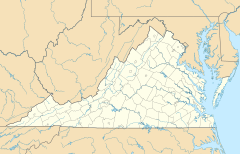Hungry Mother State Park Historic District | |
 A lake in the Park | |
| Nearest city | Marion, Virginia |
|---|---|
| Coordinates | 36°52′52″N 81°32′05″W / 36.88111°N 81.53472°W |
| Area | 3,334 acres (1,349 ha) |
| Built | 1933 |
| Architect | Myers, E.L.; et al. |
| Architectural style | Late 19th and early 20th century American movements, modern movement |
| NRHP reference No. | 07000303[1] |
| VLR No. | 086-0015 |
| Significant dates | |
| Added to NRHP | April 12, 2007 |
| Designated VLR | June 8, 2006[2] |
Hungry Mother State Park is a state park in southwestern Virginia.
Much of the land for Hungry Mother State Park was donated by local landowners to develop a new state park in Smyth County on Hungry Mother Creek. The park is one of the six original CCC parks that opened in June 1936. The park was added to the National Register of Historic Places in 2007.
Origins of name
[edit]It has frequently been noted on lists of unusual place names.[3] A legend states[4] that when the Native Americans destroyed several settlements on the New River south of the park, Molly Marley and her small child were among the survivors taken to the raiders’ base north of the park. They eventually escaped, wandering through the wilderness eating berries. Molly finally collapsed, and her child wandered down a creek. Upon finding help, the only words the child could utter were "Hungry Mother." When the search party arrived at the foot of the mountain where Molly had collapsed, they found the child's mother dead. Today, that mountain is Molly's Knob (3,270 feet), and the stream is Hungry Mother Creek.
References
[edit]- ^ "National Register Information System – (#07000303)". National Register of Historic Places. National Park Service. March 13, 2009.
- ^ "086-0015 Hungry Mother State Park Historic District". Virginia Landmarks Register. Virginia Department of Historic Resources. October 12, 2018. Retrieved December 26, 2019.
- ^ Parker, Quentin (July 18, 2010). Welcome to Horneytown, North Carolina, Population: 15: An insider's guide to 201 of the world's weirdest and wildest places. Adams Media. ISBN 9781440507397.
- ^ "National Register of Historic Places Nomination Form: Hungry Mother State Park Historic District" (PDF). Virginia Landmarks Register. Virginia Department of Historic Resources. February 26, 2007.
External links
[edit]




Well, that’s interesting to know that Psilotum nudum are known as whisk ferns. Psilotum nudum is the commoner species of the two. While the P. flaccidum is a rare species and is found in the tropical islands. Both the species are usually epiphytic in habit and grow upon tree ferns. These species may also be terrestrial and grow in humus or in the crevices of the rocks.
View the detailed Guide of Psilotum nudum: Detailed Study Of Psilotum Nudum (Whisk Fern), Classification, Anatomy, Reproduction